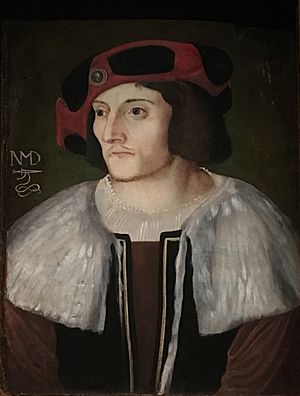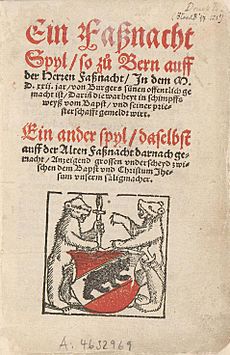Niklaus Manuel Deutsch facts for kids
Niklaus Manuel Deutsch (born around 1484, died April 28, 1530) was a very talented person from Bern, Switzerland. He was an artist, a writer, and even a soldier for hire. Later, he became an important politician who supported the Reformation in Switzerland.
Biography of Niklaus Manuel
Niklaus was likely the son of Emanuel Aleman, a pharmacist. A pharmacist prepares and sells medicines. His mother was Margaretha Fricker. Niklaus used his father's first name, "Manuel," as his last name. He also added "Deutsch" because it was the German word for his family's original name, "Alleman." He signed his artworks with the letters NMD.
He first appears in records in 1509. That year, he married Katharina Frisching. Her father was Hans Frisching, a former Bernese Landvogt (a type of local governor) and a member of the city council. Niklaus and Katharina had six children. Two of their sons, Hans Rudolf Manuel Deutsch and Niklaus Manuel Deutsch the Younger, also became artists. Niklaus Manuel is seen as the founder of the important Manuel family in Bern.
From 1510, Niklaus Manuel was a member of the city parliament, called the Grosser Rat. He was first recorded as a painter working for the city in 1513. He is considered one of the most important Renaissance painters in Switzerland, along with Hans Holbein the Younger.
In 1514, he bought a house that stayed in his family for many years. In 1516, he joined the army as a secretary for Albrecht von Stein. He took part in a French military campaign. Around 1516 or 1517, he started painting his famous danse macabre (dance of death) on a church wall in Bern. This painting was later destroyed, but a copy from 1649 still exists.
Niklaus Manuel's last signed artworks are from around 1520. After this, he focused more on writing. He used a drawing of a Swiss degen (a type of Swiss sword) with his initials NMD as his special mark. This sword also appeared on his writings. Sometimes, he even used "schwitzerdegen" as his pen name.
In 1522, he again joined Albrecht von Stein in a military campaign in Italy. He was wounded in a battle near Novara. He also fought in the Battle of Bicocca on April 27. After this battle, he wrote a funny song against the German soldiers who defeated the Swiss.
After the 1522 campaign, he became very critical of the Pope and his military actions in the Italian Wars. In the following years, he strongly supported the Swiss Reformation. This was a movement to change the church in Switzerland. He became friends with Huldrych Zwingli, who also disliked the Pope's involvement in wars.
Niklaus Manuel worked with Berchtold Haller to promote the Reformation in Bern. He wrote two plays that made fun of the Catholic Church. These plays were performed in 1522. They were very popular and helped the Reformation spread in Bern even more than sermons did. The plays were printed in 1524 and again in 1540.
In 1523, he became the Bernese Landvogt (governor) for several areas. He represented Bern at the Swiss Diet (a meeting of Swiss leaders) in 1526. From April 1528 until his death, he was a member of the city council, known as the Kleiner Rat.
Artistic Works
Literary Works
- ?1510, with Thomas Murner, Ein schon bewerts lied von der reynen unbefleckten entpfengnüß Marie ("A beautiful song about the Immaculate Conception of Mary")
- 1522, Ein Traum (a poem about the Pope's involvement in wars)
- 1522?, Nüw lied vnd verantwortung deß Sturms halb beschähn zu Pigogga ("New song and report about the attack at Biccoca")
- 1522, Underscheyd zwischen dem Bapst und Christum Jhesum (a play, "Difference between the Pope and Jesus Christ")
- 1522/3, vom Babst und seiner priesterschafft (a play, "On the Pope and his priesthood")
- 1523, Die Totenfresser ("Eaters of the Dead")
- 1525, Der Ablaßkrämer (a play, "The seller of indulgences")
- 1526, Das Barbeli (a dramatic conversation against living in monasteries)
- 1526, Fabers und Eggen Badenfahrt (a conversation, "Faber and Eck at the Conference of Baden")
- 1528, Krankheit und Testament der Messe (a funny story, "Sickness and testament of the holy mass")
The play Elsli Tragdenknaben (printed in 1530) has been linked to Niklaus Manuel. However, it is probably not his work.
See also
 In Spanish: Niklaus Manuel para niños
In Spanish: Niklaus Manuel para niños














